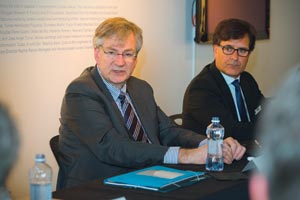Lack of Road Funding Hurts Efficiency Efforts, DTNA’s Daum Says

This story appears in the April 6 print edition of Transport Topics.
LOUISVILLE, Ky. — The head of North America’s largest heavy-duty truck maker said the U.S. government’s failure to sufficiently fund infrastructure is undermining efforts to improve fuel efficiency and reduce emissions.
“We can have the best truck, but if we have bad infrastructure, it’s not going to work,” said Martin Daum, president of Daimler Trucks North America.
He called the state of the nation’s infrastructure “a much-overlooked issue” among many in the business community.
While DTNA and other manufacturers are capable of lifting truck fuel economy and cutting emissions, tests show a 1.5-mile traffic jam “eradicates all the technology where we spent hundreds of millions” of dollars in research and development, Daum said.
“Free-flowing traffic is probably the biggest thing the government can do, and therefore, the highway bill is so important. It’s probably one of those miracles that everyone is in agreement that it’s necessary. Why don’t we get it done?” he added.
Daum made the comments during a briefing with North American trucking journalists March 26, a day after the Portland, Oregon-based manufacturer unveiled its Freightliner SuperTruck concept vehicle at the Mid-America Trucking Show here.
Similar sentiments came from Olof Persson, CEO of the Volvo Group, here March 27. In a speech to about 1,000 trucking industry representatives, he called the United States’ transportation infrastructure “inadequate.”
Meanwhile, DTNA said its Freightliner SuperTruck concept achieved 115% freight-efficiency improvement — well surpassing the 50% goal for improvements set by the U.S. Department of Energy’s program. During testing, DTNA said it also achieved 50.2% brake-thermal engine efficiency and an average result of 12.2 miles per gallon.
The test was a five-day, 312-mile round-trip route on Interstate 35 between San Antonio and Dallas, at a weight of 65,000 pounds and traveling at 65 mph.
Daimler officials estimate about 60% of the technologies used to reach its lofty results are viable or set to become reality. About 25% it called “future technology.”
Daum credited DOE for offering grants to Daimler and other equipment manufacturers to spur development of new technologies as part of the SuperTruck program. But that is an indication, he suggested, of the lack of attention being paid to the true price of the nation’s highway congestion.
He said the company is made fully aware of effects of congestion on fuel economy and emissions by trials on its more traditional 400-mile testing loop in Oregon and Idaho, which mimics a typical route and distance of many Freightliner customers.
“If we don’t get our infrastructure right in the country . . . we can do as much as possible in improving [fuel economy and emissions] — either by regulation or by research and expensive technologies — it will be blown out of the tailpipe if the truck sits for 10 minutes in a traffic jam,” he said.
Traffic congestion means engines are idling longer and emitting more carbon dioxide into the atmosphere.
Though Daum did not endorse any particular method for funding infrastructure during his hourlong presentation and question-and-answer session, this was not the first time Daimler executives have discussed the need for the federal government to assist in the business of trucking.
During his first press event in the United States as head of Daimler’s truck division, in October 2013, Wolfgang Bernhard said Congress should repeal the federal excise tax to encourage fleets to replace less-efficient models and boost fuel taxes to help replace the revenue lost by ending the sales tax. That also would encourage companies that run older trucks to replace them with more efficient ones.
At that time, Congress had begun initial negotiations for long-term funding legislation ahead of the expiration of MAP-21 on Sept. 30, 2014. The law funding surface transportation already has been extended several times in the absence of a new agreement being reached. The current extension is set to expire at the end of May.
Staff Reporter Seth Clevenger contributed to the story.

